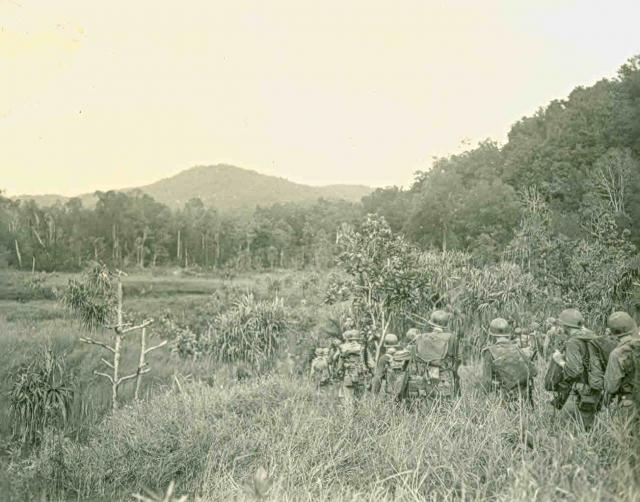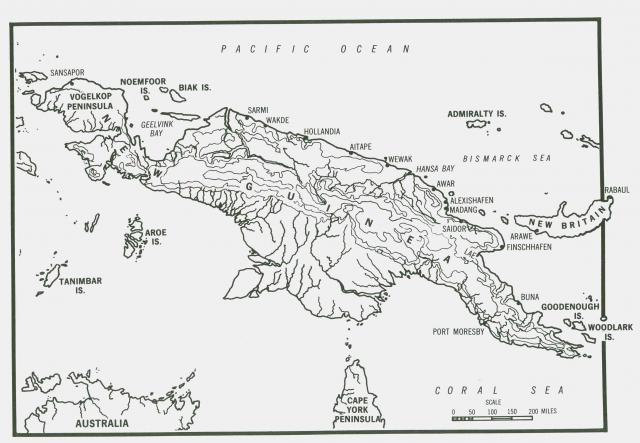- Homepage >
- News Archives >
- Article
In the Finest Traditions of the U.S. Cavalry.
August 6, 2010
By Robert M. Mages, U.S. Army Military History Institute
-

Onto the Beach:
Onto the Beach: American Soldiers moving ashore at Aitape, New Guinea, 22 April 1944. (World War II Signal Corps Collection)
-

Command Decisions:
Command Decisions: Lieutenant Colonel P.L. Hooper and Brigadier General Julian Cunningham examining a map at a command post near the Driniumor River, New Guinea, August 9, 1944.( WWII Signal Corps Collection)
-

From the Beach to the Bush!
From the Beach to the Bush! American Soldiers moving east from the beach head at Aitape into the jungle and towards the Driniumor River, New Guinea, May 1944. (WWII Signal Corps Collection).
-

New Guinea
Map of the island of New Guinea and the surrounding area. (WWII Signal Corps Collection).
By the spring of 1944 the Allies had completed the isolation of the Japanese fortress of Rabaul on the island of New Britain and were advancing steadily west along the north coast of the island of New Guinea. General Douglas MacArthur, Commander of the Southwest Pacific Area, wanted to quickly complete the conquest of this large and strategically vital island and press the attack toward the Philippines. The Imperial Japanese Army resolved to stop the Allied drive at all costs. Expecting that General MacArthur's forces would not attempt to attack outside the range of aircraft operating from Allied airbases on the Admiralty Islands, the Japanese anticipated the next blow would fall on the forces of the 18th Army based at Wewak, New Guinea. They quickly reinforced this key base.
By making use of carrier air support MacArthur's troops were able to advance beyond the range of their ground based aircraft and surprised the Japanese by landing west and to the rear of the Japanese 18th Army.
A task force composed of troops from Lieutenant General Walter Krueger's Sixth Army landed at the weakly held Japanese base at Aitape, New Guinea, on April 22, and quickly seized and fortified the local airfields, effectively cutting off the Japanese troops at Wewak.
The trapped soldiers of the Japanese 18th Army decided to go down fighting rather than wilt on the vine and perish from starvation. They formed ranks and marched west, determined to attack the American beachhead. The Allies quickly detected this move, and Sixth Army took steps to counter it.
General Krueger was a man in a hurry. Anxious to eliminate the threat posed by the advancing 18th Army, he ordered that a covering force be pushed out from the strongpoint of Aitape into the jungle along the line of the Driniumor River. Brigadier General Julian A. Cunningham's veteran 112th Cavalry Regiment was ordered forward to reinforce the under strength infantry battalions that were working to construct the outpost line.
The 112th Cavalry was a regiment from the Texas National Guard. Approximately half the size of a standard infantry regiment, the unit had been dismounted, trained as infantry, reinforced with draftees, and deployed to the Pacific in 1942. The regiment had landed on Woodlark Island off the east coast of New Guinea in July 1943 and had fought on the island of New Britain in December. These operations provided the men of the 112th Cavalry with valuable combat experience, but the troopers would face their greatest test in the steaming jungle along the banks of the Driniumor.
The regiment left its bivouac at Finschhafen, New Guinea, and landed at Aitape on June 28. After an arduous march through the jungle the troopers took up positions in the southern sector of the outpost line on July 2, and sent out patrols in search of the advancing Japanese.
The 18th Army's march from Wewak to the Driniumor was slow and tortuous. After many weeks of slogging through trackless jungle the exhausted Japanese troops formed up on the west bank of the river and prepared to attack. On July 10 the Japanese struck. They quickly overran the weak, dispersed infantry battalions holding the northern sector of the line, turning the left flank of Cunningham's cavalrymen. After two days of ferocious, confused fighting the 112th Cavalry was cut off and surrounded. The troopers established a series of strong points along the river, anchored on the village of Afua and a small hill in the bend of the river, designated as Hill 80, and prepared for a long bitter fight.
For the next several weeks the 18th Army mounted a series of desperate attacks against the outnumbered troopers of the 112th Cavalry. The difficult jungle terrain made command and control difficult for both sides, and the battle became a fight between isolated small units. Companies and platoons routinely became lost and isolated, attacking to escape encirclement or to rescue neighboring units. The confused mAfA(th)lAfAe soon became a grim battle of attrition as the fading Japanese probed for weakness during the day and launched ferocious attacks under the cover of darkness. General Cunningham redeployed and tightened the perimeter and counterattacked any penetration of his defenses. During the day the troopers of the 112th Cavalry dispatched patrols attempting to make contact with friendly units and determine the location of Japanese forces.
U.S. Army C-47 transport aircraft dropped needed supplies to the surrounded soldiers, and the heavy mortars and howitzers of the Aitape garrison helped beat back the Japanese assaults. American firepower and superior logistical support reinforced and sustained the resolute resistance of Cunningham's troopers and helped turn the tide of battle in favor of the beleaguered cavalrymen.
The task force at Aitape mounted a counterattack eastward towards the Driniumor on July 31, making contact with the tired men of the 112th Cavalry on August 4. The troopers gathered their remaining strength and attacked to reestablish the line along the river and drive the remnants of the 18th Army back into the jungle. The cavalrymen fought to the very limit of their endurance, and on August 10, with victory assured, the regiment was ordered back to Aitape. The men marched north to the mouth of the Driniumor, having suffered 320 battle casualties, nearly 30% of their pre-deployment strength.
The troopers of the 112th Cavalry broke the Japanese counterattack and eliminated a dangerous threat to the Allied drive to the Philippines. These dismounted, former horse soldiers also demonstrated the toughness and adaptability of the American Soldier.